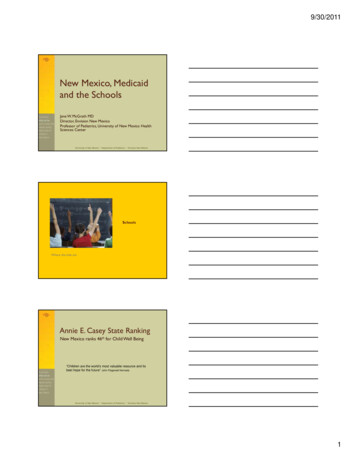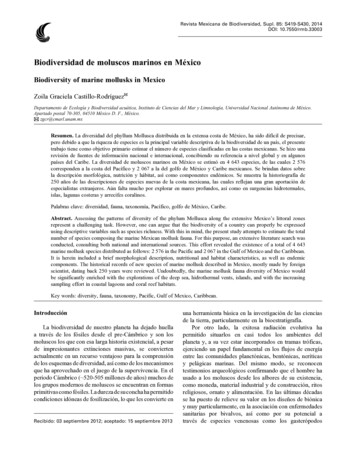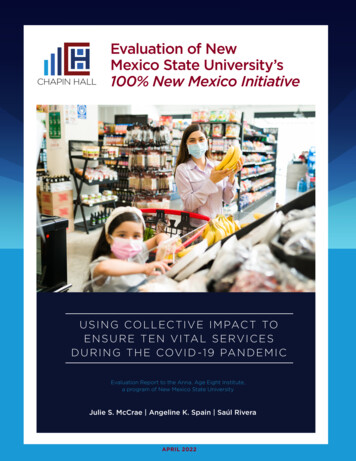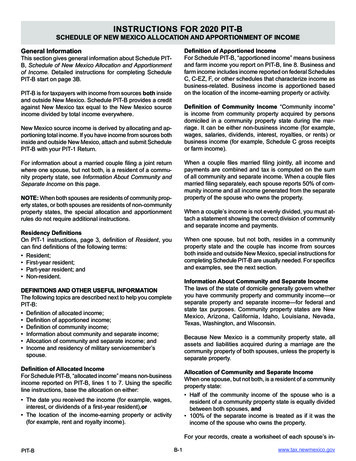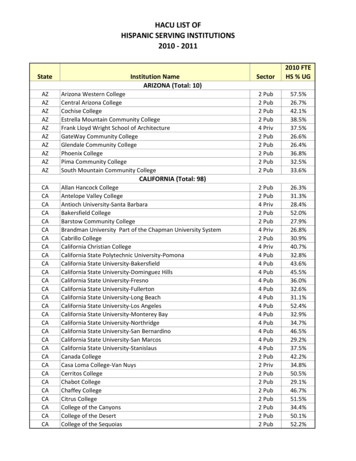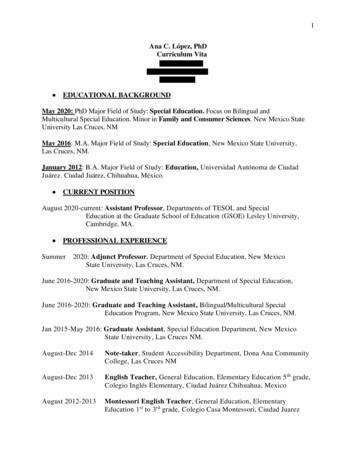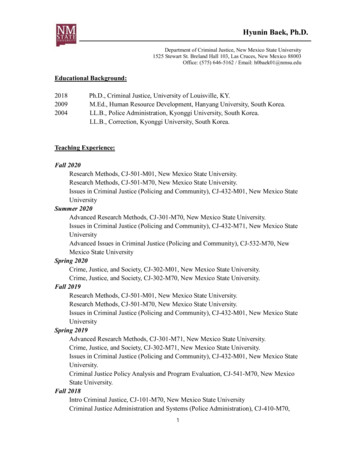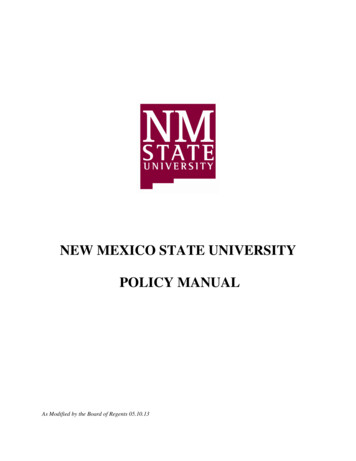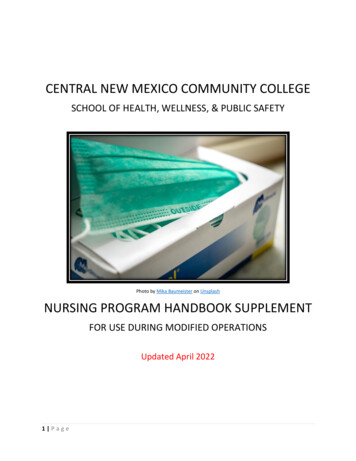
Transcription
CENTRAL NEW MEXICO COMMUNITY COLLEGESCHOOL OF HEALTH, WELLNESS, & PUBLIC SAFETYPhoto by Mika Baumeister on UnsplashNURSING PROGRAM HANDBOOK SUPPLEMENTFOR USE DURING MODIFIED OPERATIONSUpdated April 20221 Page
Table of ContentsDaily Health Self-Assessment. 3Social Distancing and General Use of PPE . 3Conduct Expectations for Online Classes and Meetings. 3Modified Attendance Policy During Times of Local or National Healthcare Crisis . 4Quarantine . 6Travel During the Program . Error! Bookmark not defined.Technology Requirements and Technology Backup Plan . 7BrightSpace Emails and Announcements . 7Online Test Proctoring . 8Student Use of Faculty Office Hours . 8Online Exam Reviews . 9N95 Masks, Fit Testing, and Facial Hair . 10The policies listed in this Handbook Supplement are in effect while the College and the community remainunder modified operations as determined by the New Mexico Department of Health and the New MexicoGovernor’s office. All policies in the Nursing Student Handbook remain in place unless the policies listedhere augment or supersede them. Students are expected to read this supplement in its entirety. Ifstudents have questions, please reach out to your full-time instructional leads OR the program director.Students will be notified in writing via email when this supplement is no longer in effect or if new policiesare put into place.2 Page
Daily Health Self-AssessmentStudents need to fill out this screening through myCNM BEFORE coming to campus, not while walking intothe building or after arrival. Students need to fill out a CNM self-assessment for the following reasons: Coming on any CNM campus to classComing on any CNM campus to labComing on any CNM campus for any meetings, services, or for studyAttending off-campus clinicalIf a student screens positive with symptoms, they may need to submit additional information toclinical partners. Clinical instructors will provide additional information as needed.Students should not report positive symptoms as “no” responses because of an assumed cause (such asa vaccine response). If the symptom is present, report it. The nuances of the symptom can be discussedduring the follow up phase of reporting.Screening tools are NOT needed in the following situations: You are engaged in learning from home through a fully DL class and not on campus at all thatdayYou have been directed to stay at home from the CNM COVID team; no screenings are neededduring mandated quarantineImplemented January 2022Social Distancing and General Use of PPEStudents are expected to follow CNM’s policies regarding use of personal protective equipment (PPE) andsocial distancing while at clinical and while on any CNM or clinical property which includes outdoor spaceand parking lots.The guidelines and requirements for mask use, social distancing, and PPE are changing too quickly tocapture in this handbook. Changes will be communicated each semester in the course syllabus. The mostup to date information for CNM’s properties can be found at this URL: https://www.cnm.edu/covid19/home. When changes occur mid-semester, students will receive email blasts from CNM and/or theprogram. The only outlier topic applicable for our program is the following on group work.Group Work: Students working together on projects should also follow social distancing. If a group isplanning to record the presentation to submit, students should strategize ways to capture the video viavideoconferencing software or to record their sections independently and then edit them into a singlepresentation. Video presentations that flaunt social distancing rules or mask mandates when in effect maybe subject to point penalties and will not be shared with the class as a whole.Updated, April 2022, January 2022, Implemented February 2021Conduct Expectations for Online Classes and MeetingsThe CNM Nursing Faculty recognize that students may be participating in learning activities from homeand that this can pose certain challenges. To help promote a safe and mutually respectful learningenvironment, the following are in place:3 Page
Students are expected in uniform and able to come on camera while speaking during classtime.o We will not stream all of you all of the time, but we will be taking attendance each classperiod. We learned over the summer that wearing the uniform sends the message to theothers in your household that you’re in class and not to be disturbed. It also preserves adegree of professionalism in the learning environment.o For smaller learning groups, your instructor may want students to be all on camera tofacilitate participation and to measure engagement. If a student is uncomfortable withcoming on camera for any reason, they should reach out to their instructor to discuss thesituation.If students must join class from their bedroom, it is important that they not be in bed. On bedis fine but the linens should be tidied. Students and faculty both verbalized significant discomfortinterfacing with individuals in class who were fully in bed. If a blanket is needed for warmth thatis fine, please wrap up while off camera, please. While on camera we should see that students aregroomed and fully dressed.Students should check their learning environment for tidiness and appropriateness of the itemsthat are in screen behind them when on camera. It is disruptive to the learning environment tohave excessive clutter, alcohol, tobacco, firearms, laundry, drug paraphernalia, or other bedroom“accessories” visible.Children and pets are part of everyday web conferencing life. If your class session is interruptedby children, pets, or other household members, it is okay. But please be aware that classroomlectures will not be toned down for children and that presentation slides can have graphiccontent. If disruptions become a distraction, faculty will address this directly with thoseindividuals.Clinical post conference must be conducted in a private setting.o During clinical pre- and/or post-conference students will have an opportunity to discussHIPAA sensitive information. Students should be alone and in a private area in theirhomes/car for these conferences. Clinical instructors may require cameras for postconference activities to ensure that conversations are private.o If a private area is not available, students are expected to wear headphones or earbudsand to speak about their patient in very general terms so that HIPAA sensitive informationis not inadvertently shared. Also, the student should share with the clinical faculty thatthe conversation could be overheard.It will be common for isolated students to attend a live, campus class remotely. Students must bemindful about minimizing side conversations to preserve the integrity of the audio stream.Updated April 2022, Reviewed January 2022, Implemented February 2021Modified Attendance Policy During Times of Local or National HealthcareCrisisDefinition: This is a policy that will go into effect during extreme situations of regional or nationalhealthcare crises (such as massive outbreaks of viral infections with high mortality rates). It is critical thatwe take immediate steps to protect not only our student/faculty population, but also to our communityhealthcare partners and the vulnerable patient populations in their care.The Center for Disease Control (CDC) recommends that healthcare organizations develop sick leave policiesfor healthcare personnel (HCP) that are non-punitive, flexible and consistent with public health guidanceto allow and encourage HCP with suspected or confirmed infection to stay home. Policies and procedures4 Page
should enhance exclusion of HCPs who develop a fever and respiratory symptoms from work andencourage them to follow the CDC protocols for exposure, symptoms, and return to work.Process:1. Students will be informed in writing (direct email as well as announcements in the learningmanagement system) of the emergency policy and the behaviors expected of them. They will bebased on current CDC recommendations.2. Clinical instructors will continue to communicate to their full-time leads of student absencesthrough weekly anecdotal notes. Tracking of absences will not change.3. Full-time faculty monitor clinical absences over the term.a. Clinical: Students who miss more than two (2) consecutive clinical days (Thurs/Fri orFri/Thurs) will submit documentation as requested in order to return to the classroomand clinical setting. Requested documentation must be given directly (either a photocopyor emailed scanned copy) to the full-time lead instructors for the course AND the programdirector.i. Full-time faculty will watch for the two (2) consecutive clinical day pattern and forexcessive absences.ii. Full time faculty will send an email to students reminding them that points cannotbe made up and that more absences are likely to have a negative impact on theirsuccess for the term.iii. Full time faculty will send an additional follow up email for each subsequentabsence.1. Students who miss class or accrue an absence due to behavioral issues(not coming prepared, coming late, insubordination, etc.) will be placedon a success plan in addition to having the absence noted in their files.2. Regardless of reason for absence, it is the responsibility of the student tomeet all course objectives. Missing clinical shifts limits the ability of theinstructor to evaluate student progression. In the absence of compellingevidence of meeting objectives, students will not be allowed to progressto the next level. Evaluation of student performance lies exclusively withthe clinical instructor.3. Students will not accrue absences if their clinical is cancelled due toinstructor illness. It is reasonable to expect that students will engage inan alternate activity in this instance.b. Classroom:i. Exams: Follow the exam policy as written in the CNM Nursing Student Handbook.ii. Quizzes or scored in-class group work: missed activities cannot be made up.iii. Students are responsible for the information presented in the class period.Students are encouraged to seek clarification during the instructor’s office hours.The faculty is not expected to re-teach the content in office hours. They will,however, answer specific questions.iv. Students are encouraged to obtain notes from classmates. It is not theresponsibility of the instructor to provide their lecture notes.4. Durationa. This policy can be implemented at any time by the director with input from faculty.b. This policy can be terminated at any time by the director with input from faculty. This willbe a data-driven decision based on appropriate agencies (NMDOH, CDC, WHO, etc.)i. At the time of emergent policy cessation, the following will occur:5 Page
1. Students will be notified in writing (via email and announcements on thelearning management system) of the date the policy reverts.2. At that time, the attendance policy, as written in the CNM nursingstudent handbook, will resume as written.3. Additional absences after the cessation of the emergency policy will behandled as follows:a. Students with two or fewer absences accrued during theemergency period will resume the term with a “clean slate.”b. Students with three or more absences during the emergencyperiod will accrue an attendance suspension with the next clinicalabsence after the policy reverts to what is published in thehandbook. See CNM nursing student handbook for details.Reviewed January 2022, Implemented February 2021QuarantineAs a nursing program, we at CNM want students to stay off quarantine as much as possible. With muchof the program moved to distance learning, this does not pose a significant problem for the lecture classes.For clinical, however, repeated quarantine will be problematic. If a quarantine period (or if a studentexperiences repeated quarantines in a single semester) overlaps a time where the assigned clinical groupis cleared to go to an offsite learning experience, students will have only the remaining clinical time todemonstrate achieved and sustained achievement of end of course objectives. It is not feasible to have astudent achieve these objectives without engaging in clinically based experiences with our off-campuspartners. We do not have the ability to provide make-up experiences. If a student misses a critical training(computer training, etc.), it is unlikely that we would be able to place that person in clinical which wouldmean they need to repeat the course. Students who are worried about this should reach out to theirnursing faculty sooner rather than later to provide for planning and contingencies.Here are some things to consider: Avoid risky behaviors. Students and faculty rely on one another to keep each other safe.Participating in in-person group activities that increase the chances of exposure, particularly whenunmasked, puts everyone at higher risk for infection.Students have an ethical responsibility to abide by quarantine orders. Do not come to campusor clinical when sick. Do not try to hide illness. Do not bypass quarantine if you fall into a categorywhere quarantine is required. Failure to assume this responsibility will result in formal referral tothe Dean of Students office and may negatively impact that student’s ability to progress in theprogram.Students who contract COVID will have varying symptom severity and recover at different rates.For many, even mild symptoms have made concentrating on studies very challenging. The fatiguecan be profound and it can be an early indication of central nervous system dysfunction.o If sick, students are encouraged to reach out to their full-time leads or to the programdirector to discuss the situation and options. It is the program’s goal to keep as manystudents engaged in learning as possible. We also recognize that COVID is a serious illnessthat requires rest and recovery.o If a student needs to pause for a term to fully recover, that option is open. Please reachout to the program director to discuss your options.Updated April 2022, January 2022, Implemented February 20216 Page
Technology Requirements and Technology Backup PlanOur program is returning to face to face instruction, but COVID cases are still prevalent. Students mayneed to isolate but may still be feeling well enough to participate in class. It is very important that studentshave access to reliable computers and internet. It is an expectation that all students are able to participatein class activities free from major technological failures. Students cannot navigate the program with onlya smart phone or tablet device. Chrome Books and Kindle Fire tablets are not compatible with several ofour online products. This link provides information about technology supports that CNM irements. There are also additional CNM resources to support online learning. This link describesthem: https://www.cnm.edu/covid-19/student-resources.We also suggest that students use an Ethernet cable to connect to your home modem to your computer,particularly if there are multiple individuals at the home accessing the internet. A wired connection ismuch more stable than a wireless one.Every student is expected to have (and utilize when needed) a multi-contingency technology backup planin case of computer or internet failure, especially on exam and clinical days. This plan often includesprovisions for travelling to a location with more stable internet so it is important to consider complicatingfactors like vehicle access and child supervision which should also be addressed in the backup plan. If yoursituation is particularly complicated, please reach out to your full-time leads to discuss and strategize,ideally in advance of the need. These links can also help: WiFi Hotspots – The official site of Rio Rancho, NMFree Outdoor WiFi Access – City of AlbuquerqueCNM Parking Lot WiFi Access (patrolled by extra security from 0600-2200 M-Sat)App Store – WiFi Map: Find Internet and VPNCNM has computers for students to check out, so if a student is concerned that their computer is not newor powerful enough to manage the technology demands associated with the program, CNM can easilyprovide one. These computers do have webcams built into them. To check one out, simply fill out thisonline form: r-program.Reviewed January 2022, Implemented February 2021BrightSpace Emails and AnnouncementsStudents need to set up notifications for announcements and should plan to check Brightspace every dayfor every course. Please note, the appropriate abbreviation of BrightSpace is BSp and not BS, thank you.We recommend the following to help you stay on top of communication: Please adjust your BSp notifications to allow announcements be pushed to you via your BSp appso you can see them on your smart devices. You are responsible for ensuring that your settingsare such that you receive announcements as they are released. Missing these because of techissues is not a valid excuse.While relying on student peers for information, students have a responsibility for their ownknowledge and performance. If students hear that something has changed, they are encouragedto verify this information by going to the source – the BrightSpace shells.7 Page
Also, be aware that students should to manage their announcements within BSp by deletingexpired announcements from view as appropriate so that new announcements are not missed.Plan to check BSp daily on M-F to ensure you are not missing important announcements. This isparticularly important on clinical days.Reviewed January 2022, Implemented February 2021Online Test ProctoringIt is critical during these modified operations to ensure testing security. We have had incidences withstudents in online classes who have consistently failed to follow directions and/or utilize academicintegrity tools like Examplify and Webcam recordings. The faculty has decided as a group that this practicecannot continue. The most cited reason for noncompliance has been technology failure.We expect students to have a technology back-up plan for all courses. For Spring 2021 and beyond,students who test remotely without following directions will have one (1) opportunity to fix the identifiedissue with consideration of having penalties waived. Any subsequent exam submitted without theseprotections will not be accepted for grading and the student will be referred to the Dean of StudentsOffice for possible action under the Academic Integrity Policy and/or the Student Code of Conduct.Reviewed January 2022, Implemented February 2021Student Use of Faculty Office HoursFull-time faculty offer five (5) office hours per week; one (1) hour per course section taught. Part-timefaculty offer four (4) office hours per week. Office hours are recommended to be adjacent to class time,if possible. Faculty are careful to offer office hours that do not conflict with other nursing courses, but notall office hours may be available to all students. Clinical office hours are usually offered the hour beforeand immediately after clinical shifts. At the beginning of the term, students who need to discuss disabilityresource center (DRC) accommodations will be given priority scheduling over other students in the firsttwo weeks of each term.Office hours can be honored face to face and we will continue to offer hours via web conferencing. It isreasonable for faculty to ask that student appointments not exceed 15 minutes per session. During peaktimes (after exams, toward the end of the term) faculty may further restrict meeting durations.In order to make the most effective use of these meetings, please consider these action:1. When your instructor is offering face to face or virtual appointments, show up at least ten (10)minutes early to your appointment. Students will start the conference in a virtual lobby andbrought into the office hours “room” one student at a time. Upon arrival to the web conferencestudents should send a private chat to the instructor so they can ensure that student meetingshappen in order. If the faculty is ahead of schedule, they may message individuals in chat as towho is next. If students miss their appointment or do not respond when their name is called, theywill be asked to make a new one at another time.2. When your instructor has open office hours without appointments: Some faculty prefer to takestudents on a first-come-first-served basis. Students will join the session starting in a virtual lobbyand be brought into the office hours “room” one student at a time. Upon arrival to the webconference students should send an email to the instructor so they can ensure that studentmeetings happen in order. If students do not respond when their name is called, they will be askedto join office hours at another time. Students are always empowered to email questions to facultyas well, but not all questions asked are appropriate to be answered in this manner (complicated,nuanced, or very broad topics as examples).8 Page
3. Recognize that not all students may be able to use office hours on demand. Faculty are notexpected to extend office hours to accommodate unscheduled appointments or students whoshow up in the last ten minutes of a scheduled session. Faculty will do their best to clear thequeue, but even under the most ideal of circumstances, there may be days when students cameearly to office hours and still cannot be seen.4. Time is a limited resource. Understand that faculty will have to set limits. Office hours are noton demand. They are usually offered Monday through Friday at scheduled times during normalworking hours. Evenings and weekends are time for faculty to rest, recharge, and reconnect withtheir other obligations to family, their own educational pursuits, other jobs, hobbies,volunteerism, and spiritual obligations. They cannot be at their best for you, the students, if theycannot be at their best for themselves. Faculty can, of course, schedule weekend office hours ifthey choose, but this is not an institutional expectation.5. Have your list of specific questions ready to go. Being prepared will provide you with the bestoffice hour experience. There is a difference between, “I don’t understand acid base balance,”and, “I am struggling with the difference between compensated and uncompensated arterialblood gas values.”6. Utilize your clinical instructor’s office hours to help with classroom concepts. Clinical coursesare considered synthesis courses and our clinical faculty are very good at helping students see thebigger picture from a clinical/application standpoint.7. Utilize discussion boards and email to ask questions: If you have a question, it’s likely that othersdo, too. Utilizing a discussion board can be an effective way to ask questions or disseminateinformation. If you are not able to connect with your instructor, know that you are empoweredto ask questions via email. Instructors are expected to respond to emails within 48 hours underusual conditions.8. Honor the meeting begin and end times. It is neither fair to your instructor nor your studentpeers to push beyond the meeting end time. If you still have questions, or if the conversationbetween you and your instructor sparked more questions, follow up with the full-time faculty viaemail, attend another office hour offering, or reach out to your clinical instructor to bridge thegaps.Revised January 2022, Implemented February 2021Online Exam ReviewsWe are back to face to face operations, but we could be asked to revert to remote learning. This processis in effect if/when in-class exam reviews (usually as collaborative exams) are not feasible. During normaloperations it is relatively simple to provide exam access to multiple students under very controlledconditions. During COVID times, however, we lack these controlled conditions.Exam questions take about an hour each to research, write, and refine. A 50-question exam typically takesabout 50 hours to develop. Faculty review these questions before and after exams and collect validity andreliability statistics on each test item representing another one (1) to two (2) hours of analysis pre/postexams. Faculty are rightfully protective of these assessment tools; having just one exam copied or leakedrepresents a huge amount of work to rebuild.Students are welcome to use office hours to review exams. To help enhance test integrity and to protectstudents, the following will be in effect for exam reviews:1. Students will review exams during office hours.9 Page
a. Students have 15 minutes max for this review (many faculty may restrict this activity toten (10) minutes, depending on class size).b. In order to streamline the experience, faculty will only review test items that studentsmissed.2. Students must have a working webcam in order to review exams. If faculty cannot see you, youmay not see the exam.a. Students will not be permitted to take notes or record the exam review session in anymanner.b. Students’ hands must be visible at all times during the review session. Faculty may askthat the camera be panned to view the students’ work stations before the review starts.c. Lack of compliance with these restrictions may result in the termination of the review.Further, faculty reserve the right to terminate an exam review at any time for any reason.A terminated review session will be followed up with a virtual meeting between thefaculty and student to discuss at a later time, ideally within five (5) working days.3. To facilitate remediation, faculty are encouraged (but are not required) to provide students an inclass recap of student performance as a whole and may revisit the “most missed” test itemspresented as concepts and not full-text test questions.Revised January 2022, Implemented February 2021N95 Masks, Fit Testing, and Facial HairOur hospital partners are beginning to allow students into COVID care areas. In order for us to accessthese units, we have been asked to fit test students assigned to those areas with the N95 mask brandsand sizes that the hospital partner decrees. If you have been fit tested at Albuquerque Ambulance, Presbyterian Healthcare, any Lovelacefacility, University Health Sciences Center (includes University Hospital and Sandoval RegionalMedical Center), or the Veteran’s Administration Hospital in Albuquerque, please send a copy ofthat fit testing certification to compliance@cnm.edu so we can add that information to your files.It is the student’s responsibility to know the size, model number, and brand of mask. Instructorswill have copies of information from CNM fit testing, but it is an important safety measure forstudents should know what masks will protect them.Fit testing at one facility does not ensure fit testing at all facilities. You may be asked to attendfit testing prior to clinical placement and you may be required to fit test to multiple masks.Students with facial hair will need to remove that hair prior to fit testing and when wearing N95masks. Fit testing requires a tight seal on the face. Students who experience heavy facial hairgrowth should plan to be clean shaven on clinical days. Insufficient mask fit due to facial hairgrowth may result in being dismissed home for the day.Students should not eat, drink, or smoke for at least fifteen minutes before being fit tested. TheCNM fit testing team is asking that this 15-minute window be extended to 60 minutes to avoidfalse fails and to keep our large volumes of fit test schedules on track.Students seeking a religious exemption for shaving should notify the nursing program director inadvance of the term to discuss. Notifying CNM after the start of the term may result in a delay inclinical placement to the next semester due to the complexities of credentialing requirements.Revised January, 2022; Implemented February 202110 P a g e
See CNM nursing student handbook for details. Reviewed January 2022, Implemented February 2021 Quarantine As a nursing program, we at CNM want students to stay off quarantine as much as possible. With much of the program moved to distance learning, this does not pose a significant problem for the lecture classes.
